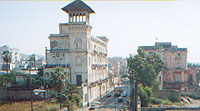
Herculaneum, once called Heracleia, is an ancient town lying 5 miles (8 Km) southest of Naples, South Italy, on the western slopes of Mount Vesuvius. It is undoubtedly one of the most fascinating town of the Naples area because it is not only famous as an important archeological site, but also as a lively town which offers a variety of beautiful scenery and unvaluable arts. Apart from a visit to the ruins and the Volcano, it is worth visiting the Vesuvian Villas, such as Villa Campolieto, Villa Signorini, Villa Ruggiero, Villa Favorita, the Second-hand Market, the medieval Pugliano Church and the Astronomic Observatory which has now become a Museum.
The ancient town, of Greek origins, was destroyed and buried, together with Pompei, Oplontis, Stabiae and other small villages by the Vesuvius eruption of A.D. 79. During the mid-eighteenth century excavations of part of the buried town brought to light the marine side of the old town. A lot of human skeletons were found at the ancient shoreline, suggesting that numerous inhabitants attempted to escape but perished because of the pyroclastic flow and the volcanic gases. The escavation had began quite by accident in 1709 when during the digging of a well, some workers discovered a wall which was later found to be one of the stages of the ancient theatre. Regular excavations were started later under the patronage of Carlo III Borbone, the king of the Reign of Naples who appointed the engineer Karl Weber as director of excavations. Numerous buildings and manufacts were uncovered and Karl Weber documented all of them but this was not sufficient to prevent that most of the artifacts were removed by treasure hunters. One of the most important and fascinating discoveries was the excavation of Villa of the Papyri, a suburban villa, where a large number of ancient papyri written in Greek and Latin, were discovered together with marvellous bronzes and marble works. The ancient papyri, most of which dealing with the philosophical subjects of Epicurean inspiration are still object of study and are preserved at the Archeological National Museum of Naples.
The excavations were then discontinued and were alternatively abandoned and resumed for almost two hundred years because of the difficulties given by the compact mass of tufaceous material and the infiltration of water into the ruins. They were resumed in 1927 under the direction of Amedeo Maiuri and most of the public monuments of the old town were uncovered. The special condition under which Herculaneum was buried preserved most of the buildings and made possible the conservation of magnificent paintings, wooden furniture, pieces of cloth and splendid jewelleries which offer a detailed information about the life of the old inhabitants of the Naples coast. This information are very difficulty achieved in other centres of the ancient roman society because the romans, unlike other populations, did not have the tradition of burying the dead with their own belongings. The excavations of Herculaneum which, together with those of Pompei, had precipitated the modern science of archeology, are still continuing but although the ruins were declared a Unesco World Heritage Site, they are bound restricted by the presence of the inhabited dwellings of the present town.
After the eruption of 79 A. D. the memory of the existence of Herculaneum had been lost for centuries. No one knows the date of the foundation of the new town of Resina, which was built in the same place. We know for sure that in 121 A.D. the Roman emperor Adrian ordered the re-opening of the road from Naples to Salerno and surely someone started building dwellings in this area. We have to wait until year 1060 for the first written documentation reporting of the Pugliano church which was already famous for its preservation of two ancient roman sarcophagi. The church was surrounded by a village which developed in the town of Resina (re-named Ercolano in 1969). Resina which had to face numerous eruptions of the Vesuvius, was also attacked by different populations and became a dukedom during the Angevin domination. Its population had to pay an incredible amount of money to get freedom in 1868. During the eighteenth century, when the king of Naples decided to build his Palace in Portici, a new era started for Resina. A lot of beautiful villas where built along the Golden Mile and Resina became one of the most famous balneary place in the bay of Naples. The area was known to be a whealthy place and the king himself choose this town to build a villa which had the remembrance of the Schonbrun Palace in Vienna and was the favourite of his wife. Villa Favorita, together with other splendid villas, host a lot of aristocrats and diplomats and soon became the most famous and enjoyable place for a splendid holiday. A funicular was built to take tourists up on the slopes of the Volcano and Resina became very famous all over the world for its beautiful sceneries. The two world wars caused the end of this golden age for the aristocrats of the area and the town returned to its normal life.
For more detailed information and to see photos of the ruins, please visit the following sites:
http://wings.buffalo.edu/AandL/Maecenas/italy_except_rome_and_sicily/herculaneum/section_contents.html
http://www.theplumber.com/pom.html
http://www.channel4.com/history/microsites/P/pompeii/programme.htm#herc
http://Unesco
If you are coming from a search engine please visit our home page otherwise return to top
|
|
Up
|
© 2002-2021 Maria Sannino All rights reserved
